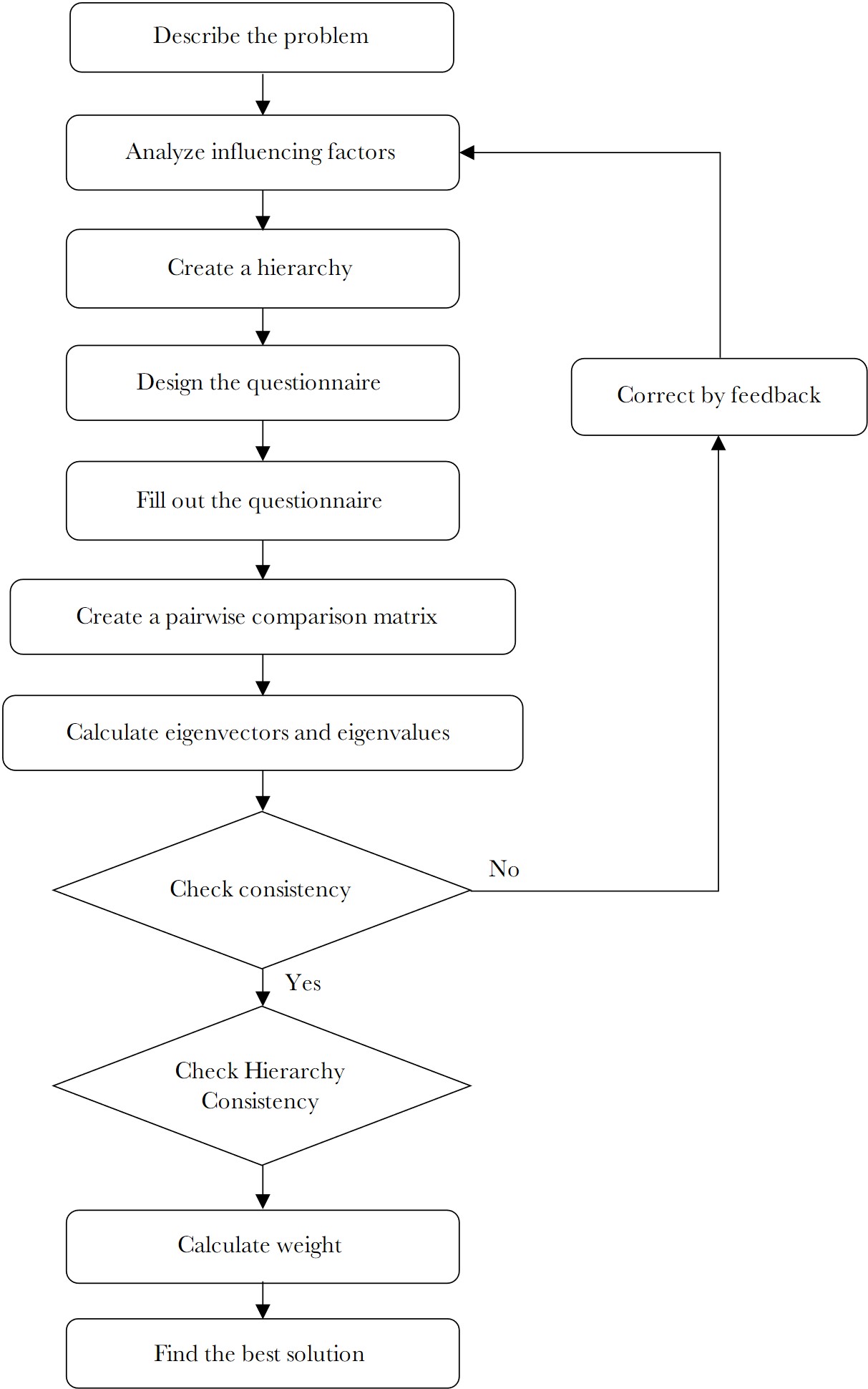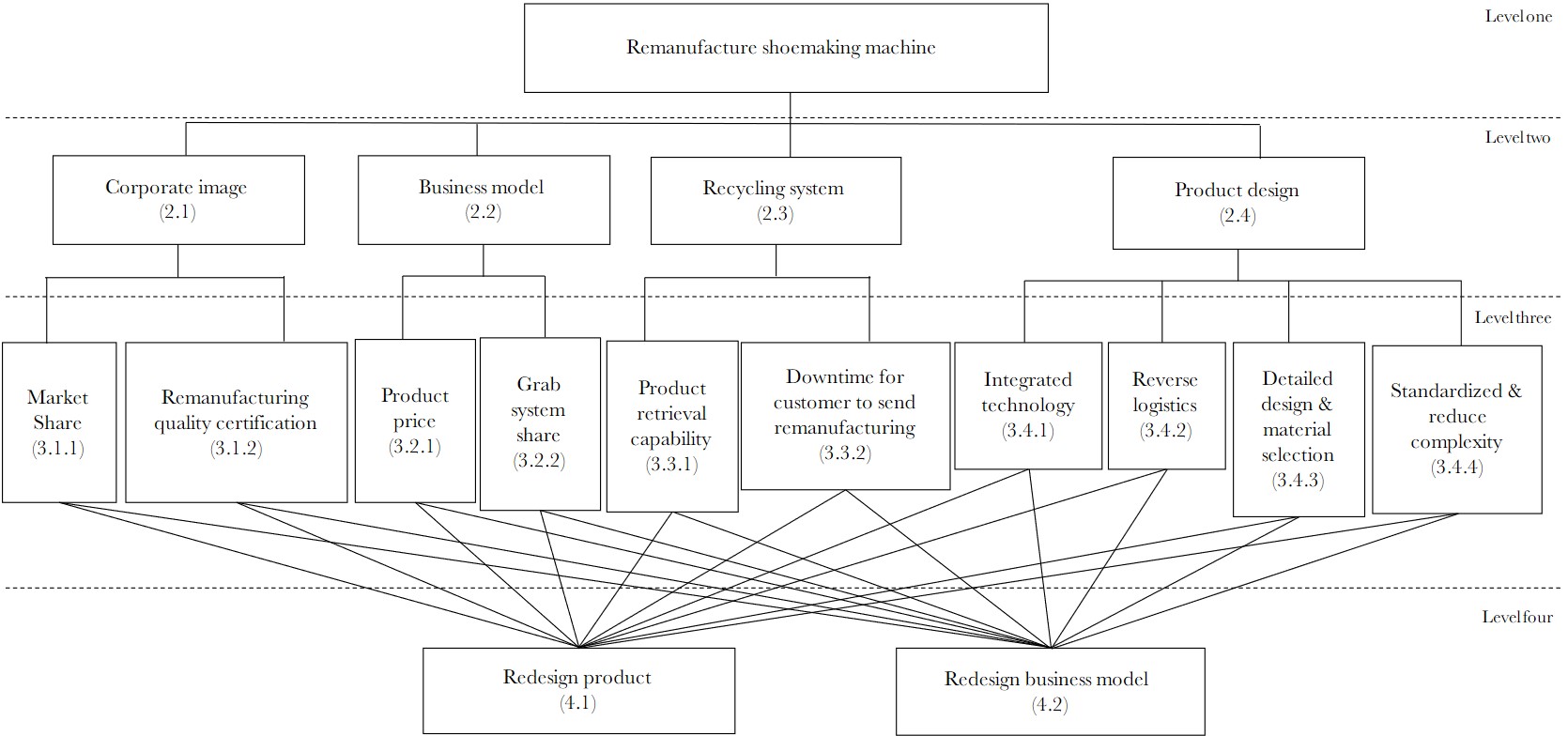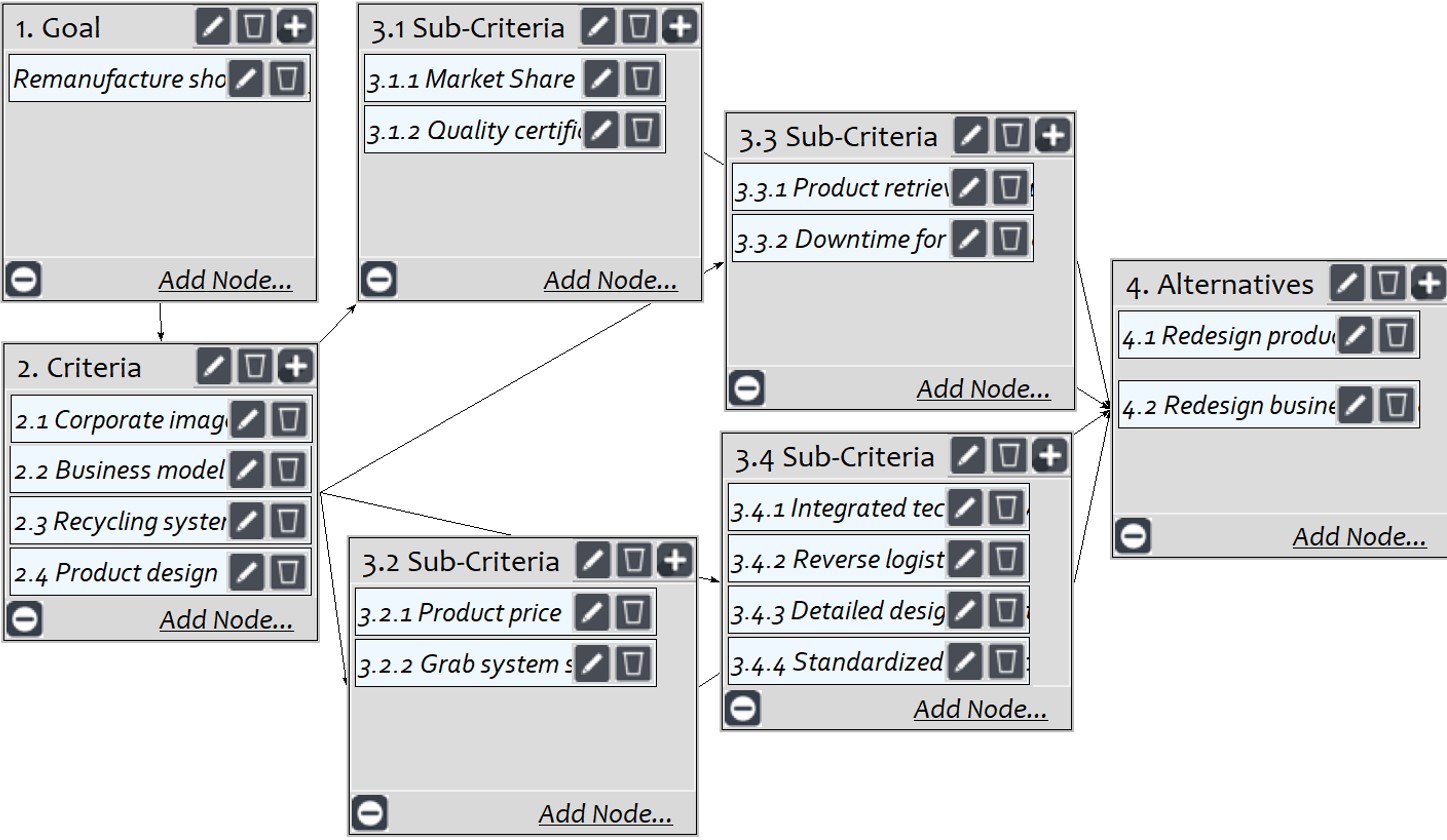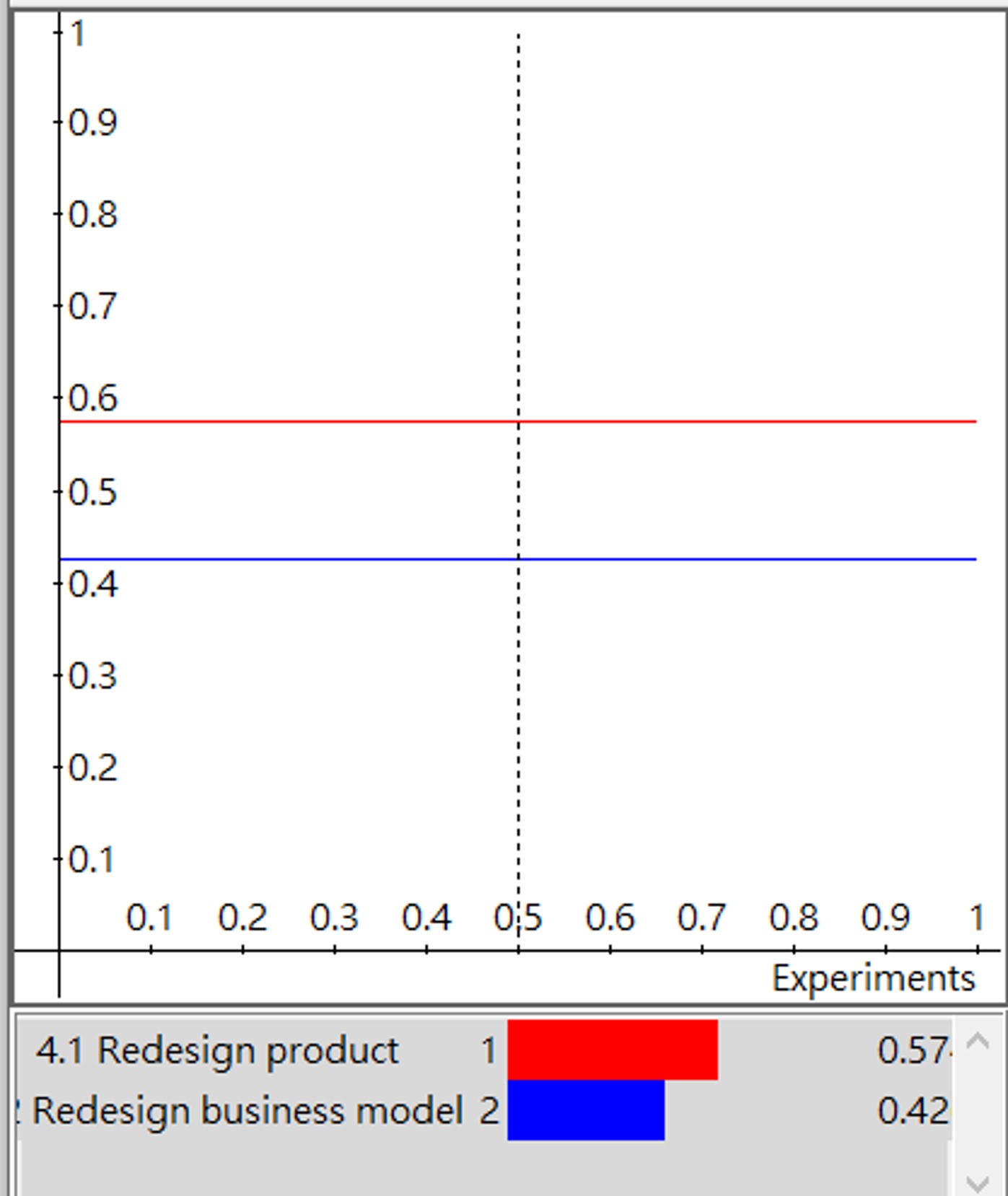Article Peer-Reviewed
Feasibility of Remanufacturing in Shoemaking Machines under the Trend of Net-zero Carbon Emissions
1
Department of Industrial Engineering and Management, National Taipei University of Technology, Taipei 106344, Taiwan
2
Department of Information Management, Kainan University, Taoyuan 33857, Taiwan
*
For correspondence.
Received: 15 February 2023 Accepted: 1 June 2023 Published: 17 June 2023
This article is part of the Special Issue Capturing the Sustainable Impact of Early-Stage Business Models.
Abstract
Achieving net-zero carbon emissions by 2050 has become a common goal in the world. An effective strategy to reduce carbon emissions will be the key to maintaining international competitiveness. Although green energy exchange is mature around the world, the relevant systems and regulations in Taiwan are not yet ready. This research examines the feasibility of shoemaking machines remanufacturing and tries to seek effective strategies to achieve carbon neutrality for the original equipment manufacturers (OEMs) of shoemaking machines. The evaluation of remanufacturing in a shoemaking machine is based on imprecise and fuzzy information. First, the feasibility evaluation model of remanufacturing in a shoemaking machine is established, including technical, economic, and resource environment feasibility criteria. Second, the comprehensive benefit evaluation model of the remanufacturing shoemaking machine is established, in which the weight of each criterion is determined by the Analytic Hierarchy Process (AHP). Finally, combined with the questionnaire, the evaluation method is verified and analyzed. The results show that the four criteria (clusters) for remanufacturing shoemaking machines have different weights, in descending order: Product design, Business model, Recycling system, and Corporate image. This implies that Product design is the most important factor for remanufacturing shoemaking machines, followed by the Business model, Recycling system, and Corporate image. Therefore, to succeed in the circular economy, OEMs need to rethink how to redesign their products from the beginning and create a new business model.
Figures in this Article
Keywords
Copyright © 2023
Chen et al. This article is distributed under the terms of the Creative Commons Attribution License (CC BY 4.0), which permits unrestricted use and distribution provided that the original work is properly cited.
Cite this Article
Chen, W.-J., Lin, R.-H., & Chuang, C.-L. (2023). Feasibility of Remanufacturing in Shoemaking Machines under the Trend of Net-zero Carbon Emissions. Highlights of Sustainability, 2(2), 110–137. https://doi.org/10.54175/hsustain2020010
References
1.
Council of the EU. (29 June 2022). Fit for 55 package: Council reaches general approaches relating to emissions reductions and their social impacts. https://www.consilium.europa.eu/en/press/press-releases/2022/06/29/fit-for-55-council-reaches-general-approaches-relating-to-emissions-reductions-and-removals-and-their-social-impacts (accessed 9 January 2022).
2.
GreenPeace. (2021). The Net Zero Game is Coming: Report on the Impact of International Carbon Border Tax on Taiwan.
3.
Han, X., Yang, Q., Shang, J., & Pu, X. (2017). Optimal strategies for trade-old-for-remanufactured programs: Receptivity, durability, and subsidy. International Journal of Production Economics, 193, 602–616. https://doi.org/10.1016/j.ijpe.2017.07.025
4.
Zhuang, X., Song, X., Yang, H., Zhao, D., Wu, W., & Zhao, J. (2023). The energy saving and GHG mitigation benefits assessment of product remanufacturing from a multi-life cycle perspective: A case study of spark plug. Environmental Impact Assessment Review, 99, 107018. https://doi.org/10.1016/j.eiar.2022.107018
5.
Technavio. (2022). Industrial Machinery Remanufacturing Market by End-user and Geography - Forecast and Analysis 2022–2026. Infiniti Research Limited. https://www.technavio.com/report/industrial-machinery-remanufacturing-market-industry-analysis (accessed 9 January 2022).
6.
Xu, Z., Elomri, A., Pokharel, S., & Mutlu, F. (2019). The Design of Green Supply Chains under Carbon Policies: A Literature Review of Quantitative Models. Sustainability, 11(11), 3094. https://doi.org/10.3390/su11113094
7.
Ansari, Z. N., & Daxini, S. D. (2022). A State-of-the-Art Review on Meta-heuristics Application in Remanufacturing. Archives of Computational Methods in Engineering, 29(1), 427–470. https://doi.org/10.1007/s11831-021-09580-z
8.
Sousa, S. D., & Pham, D. T. (2023). Quality Control in Remanufacturing: Distinguishing Features and Techniques. In K.-Y. Kim, L. Monplaisir, & J. Rickli (Eds.), Flexible Automation and Intelligent Manufacturing: The Human-Data-Technology Nexus. Springer Cham. https://doi.org/10.1007/978-3-031-17629-6_57
9.
Masoumik, S. M., Abdul-Rashid, S. H., & Olugu, E. U. (2015). The Development of a Strategic Prioritisation Method for Green Supply Chain Initiatives. PLoS ONE, 10(11), 1–33. https://doi.org/10.1371/journal.pone.0143115
10.
Ghosh, S., Mandal, M. C., & Ray, A. (2023). A PDCA based approach to evaluate green supply chain management performance under fuzzy environment. International Journal of Management Science and Engineering Management, 18(1), 1–15. https://doi.org/10.1080/17509653.2022.2027292
11.
Sundin, E., & Bras, B. (2005). Making functional sales environmentally and economically beneficial through product remanufacturing. Journal of Cleaner Production, 13(9), 913–925. https://doi.org/10.1016/j.jclepro.2004.04.006
12.
Ghoreishi, M., Treves, L., Teplov, R., & Pynnönen, M. (2023). The Impact of Artificial Intelligence on Circular Value Creation for Sustainable Development Goals. In F. Mazzi & L. Floridi (Eds.), The Ethics of Artificial Intelligence for the Sustainable Development Goals (pp. 347–363). Springer Cham. https://doi.org/10.1007/978-3-031-21147-8_19
13.
Konstantaras, I., Skouri, K., & Benkherouf, L. (2021). Optimizing inventory decisions for a closed–loop supply chain model under a carbon tax regulatory mechanism. International Journal of Production Economics, 239, 108185. https://doi.org/10.1016/j.ijpe.2021.108185
14.
Mathiyazhagan, K., Rajak, S., Sampurna Panigrahi, S., Agarwal, V. & Manani, D. (2021). Reverse supply chain management in manufacturing industry: a systematic review. International Journal of Productivity & Performance Management, 70(4), 859–892. https://doi.org/10.1108/IJPPM-06-2019-0293
15.
Vlachos, I. P. (2016). Reverse logistics capabilities and firm performance: the mediating role of business strategy. International Journal of Logistics: Research & Applications, 19(5), 424–442. https://doi.org/10.1080/13675567.2015.1115471
16.
Oliveira, L. S., & Machado, R. L. (2021). Application of optimization methods in the closed-loop supply chain: a literature review. Journal of Combinatorial Optimization, 41(2), 357–400. https://doi.org/10.1007/s10878-020-00677-y
17.
Condeixa, L. D., Silva, P., Moah, D., Farias, B., & Leiras, A. (2020). Evaluating cost impacts on reverse logistics using an Economic Order Quantity (EOQ) model with environmental and social considerations. Central European Journal of Operations Research, 30, 921–940. https://doi.org/10.1007/s10100-020-00707-4
18.
Lee, C.-M., Woo, W.-S., & Roh, Y.-H. (2017). Remanufacturing: Trends and issues. International Journal of Precision Engineering and Manufacturing-Green Technology, 4, 113–125. https://doi.org/10.1007/s40684-017-0015-0
19.
Chari, N., Diallo, C., & Venkatadri, U. (2014). State of the Art on Performability across the Sustainable Value Chain. International Journal of Performability Engineering, 10(6), 543–556.
20.
Steingrímsson, J. G., Bilge, P., Heyer, S., & Seliger, G. (2011). Business Strategies for Competition and Collaboration for Remanufacturing of Production Equipment. In G. Seliger, M. Khraisheh, & I. Jawahir (Eds.), Advances in Sustainable Manufacturing. Springer. https://doi.org/10.1007/978-3-642-20183-7_14
21.
Okorie, O., Russell, J., Cherrington, R., Fisher, O., & Charnley, F. (2023). Digital transformation and the circular economy: Creating a competitive advantage from the transition towards Net Zero Manufacturing. Resources, Conservation and Recycling, 189, 106756. https://doi.org/10.1016/j.resconrec.2022.106756
22.
Cunha, V. P., Balkaya, I., Palacios, J., Rozenfeld, H., & Seliger, G. (2011). Development of Technology Roadmap for Remanufacturing Oriented Production Equipment. In G. Seliger, M. Khraisheh, & I. Jawahir (Eds.), Advances in Sustainable Manufacturing (pp. 203–208). Springer. https://doi.org/10.1007/978-3-642-20183-7_30
23.
Du, Y., Zheng, Y., Wu, G., & Tang, Y. (2020). Decision-making method of heavy-duty machine tool remanufacturing based on AHP-entropy weight and extension theory. Journal of Cleaner Production, 252, 119607. https://doi.org/10.1016/j.jclepro.2019.119607
24.
Jiang, Z., Zhang, H., & Sutherland, J. W. (2011). Development of multi-criteria decision making model for remanufacturing technology portfolio selection. Journal of Cleaner Production, 19(17), 1939–1945. https://doi.org/10.1016/j.jclepro.2011.07.010
25.
Ramírez, F. J., Castellani, M., & Xu, W. (2023). Autonomous remanufacturing for sustainability. The International Journal of Advanced Manufacturing Technology, 124(9), 2969–2970. https://doi.org/10.1007/s00170-022-10680-8
26.
Sitcharangsie, S., Ijomah, W., & Wong, T. C. (2019). Decision makings in key remanufacturing activities to optimise remanufacturing outcomes: A review. Journal of Cleaner Production, 232, 1465–1481. https://doi.org/10.1016/j.jclepro.2019.05.204
27.
Du, Y., Cao, H., Liu, F., Li, C., & Chen, X. (2012). An integrated method for evaluating the remanufacturability of used machine tool. Journal of Cleaner Production, 20(1), 82–91. https://doi.org/10.1016/j.jclepro.2011.08.016
28.
Shu, T., Wu, Q., Chen, S., Wang, S., Lai, K. K., & Yang, H. (2017). Manufacturers’/remanufacturers’ inventory control strategies with cap-and-trade regulation. Journal of Cleaner Production, 159, 11–25. https://doi.org/10.1016/j.jclepro.2017.05.021
29.
Majumder, P., & Groenevelt, H. (2001). Competition in remanufacturing. Production and Operations Management, 10(2), 125–141. https://doi.org/10.1111/j.1937-5956.2001.tb00074.x
30.
Chen, S., Pan, Y., Wu, D., & Dolgui, A. (2023). In-house versus outsourcing collection in a closed-loop supply chain with remanufacturing technology development. International Journal of Production Research, 61(6), 1720–1735. https://doi.org/10.1080/00207543.2022.2045376
31.
Berkel, R. V., & Ramchandra, R. (21 September 2020). India: Building back better through remanufacturing. United Nations Industrial Development Organization (UNIDO). https://www.unido.org/stories/india-building-back-better-through-remanufacturing (accessed 4 February 2022).
32.
U.S. International Trade Commission. (2012). Remanufactured Goods: An Overview of the U.S. and Global Industries, Markets, and Trade (USITC Publication 4356). http://www.usitc.gov/publications/332/pub4356.pdf (accessed 4 February 2022).
33.
Forward. (2020). Report of Prospect and Investment Forecast Analysis on China Remanufacturing Industry (2022–2027).
34.
National Center for Climate Change Strategy and International Cooperation (NCSC). (2018). The People’s Republic of China Third National Communication on Climate Change. https://unfccc.int/sites/default/files/resource/China_NC3_Chinese_0.pdf (accessed 4 February 2022).
35.
Sinha, A. K. (2013). Feasibility of remanufacturing in india a study of automobile sector [Ph.D Thesis, IIT (ISM) Dhanbad]. Shodhganga@INFLIBNET. http://hdl.handle.net/10603/32886
36.
Choudhary, N., & Singh, N. (2011). Remanufacturing in India: Approaches, Potentials & Technical challenges. International Journal of Industrial Engineering and Technology, 3, 223–227.
37.
Ahuja, V., & Terkar, R. (2020). Remanufacturing Benefits: An Analysis of Recent Trends in Indian Context. IOP Conference Series: Materials Science and Engineering, 810, 012068. https://doi.org/10.1088/1757-899X/810/1/012068
38.
Parker, D., & Robinson, S. (2015). Remanufacturing Future Market Report (Ref. Ares (2016) 217725 - 15/01/2016). European Commission.
39.
Zacharaki, A., Vafeiadis, T., Kolokas, N., Vaxevani, A., Xu, Y., Peschl, M., et al. (2021). RECLAIM: Toward a New Era of Refurbishment and Remanufacturing of Industrial Equipment. Frontiers in Artificial Intelligence, 3, 570562. https://doi.org/10.3389/frai.2020.570562
40.
Kurilova, J., Sundin, E., & Poksinsha, B. (2018). Remanufacturing challenges and possible lean improvements. Journal of Cleaner Production, 172, 3225–3236. https://doi.org/10.1016/j.jclepro.2017.11.023
41.
Golinska-Dawson, P., & Kubler, F. (Eds.). (2018). Sustainability in remanufacturing operations. Springer Cham. https://doi.org/10.1007/978-3-319-60355-1
42.
Ijomah, W. L., McMahon, C. A., Hammond, G. P., & Newman, S. T. (2007). Development of design for remanufacturing guidelines to support sustainable manufacturing. Robotics and Computer-Integrated Manufacturing, 23(6), 712–719. https://doi.org/10.1016/j.rcim.2007.02.017
43.
Lindkvist, L., & Sundin, E. (2016). The role of Product-Service Systems regarding information feedback transfer in the product life-cycle including remanufacturing. Procedia CIRP, 47, 311–316. https://doi.org/10.1016/j.procir.2016.03.088
44.
Vogt Duberg, J., Johansson, G., Sundin, E., & Kurilova-Palisaitiene, J. (2020). Prerequisite factors for original equipment manufacturer remanufacturing. Journal of Cleaner Production, 270, 122309. https://doi.org/10.1016/j.jclepro.2020.122309
45.
Ekins, P., Domenech, T., Drummond, P., Bleischwitz, R., Hughes, N., & Lotti, L. (2019). The Circular Economy: What, Why, How and Where. In Managing Environmental and Energy Transitions for Regions and Cities. Organisation for Economic Co-operation and Development (OECD).
46.
Dils, E. (2021). ETC/WMGE Report 10/2021: Contribution of remanufacturing to circular economy. The European Environment Information and Observation Network (Eionet).
47.
Guidat, T., Seidel, J., Kohl, H., & Seliger, G. (2017). A Comparison of Best Practices of Public and Private Support Incentives for the Remanufacturing Industry. Procedia CIRP, 61, 177–182. https://doi.org/10.1016/j.procir.2016.11.265
48.
Östlin, J., Sundin, E. & Björkman, M. (2008). Importance of Closed Loop Supply Chain Relationships for Product Remanufacturing. International Journal of Production Economics, 115(2), 336–348. https://doi.org/10.1016/j.ijpe.2008.02.020
49.
Bauer, T. (2020). Characterization of circular strategies to better design circular industrial systems. Journal of Remanufacturing, 10(3), 161–176. https://doi.org/10.1007/s13243-020-00083-x
50.
Chang, K.-F. (2017). Super Decisions Software Operation Manual: Using ANP to break through the research limitations of AHP. Dingmao Book Publishing.
51.
Johnson, M. R., & McCarthy, I. P. (2014). Product recovery decisions within the context of Extended Producer Responsibility. Journal of Engineering and Technology Management, 34, 9–28. https://doi.org/10.1016/j.jengtecman.2013.11.002
52.
Munot, M. A., & Ibrahim, R. N. (2013). Remanufacturing Process and Its Challenges. Journal of Mechanical Engineering and Sciences, 4, 488–495. https://doi.org/10.15282/jmes.4.2013.13.0046
53.
Saaty, R. W. (1987). The analytic hierarchy process—what it is and how it is used. Mathematical Modelling, 9(3), 161–176. https://doi.org/10.1016/0270-0255(87)90473-8
54.
Super Decisions Creative Decisions Foundation. (2023). SuperDecisions (Version 3.2) [Decision support software that implements the AHP and ANP]. https://www.superdecisions.com
55.
Momoh, J. A., & Zhu, J. (1999). Multiple indices for optimal reactive power pricing and control. Decision Support Systems, 24(3), 223–232. https://doi.org/10.1016/S0167-9236(98)00076-1
56.
Saaty, T. L. (1996). Decision making with dependence and feedback: The analytic network process (Vol. 4922). RWS publications Pittsburgh.
57.
Stretton, S. (2020). A Simple Methodology for Calculating the Impact of a Carbon Tax In (p. 32). World Bank Group.
58.
Saha, N., Swetapadma, A., & Mondal, M. (2023). A Brief Review on Artificial Neural Network: Network Structures and Applications. In 2023 9th International Conference on Advanced Computing and Communication Systems (ICACCS) (pp. 1974–1979). IEEE. https://doi.org/10.1109/ICACCS57279.2023.10112753
59.
Schultz, C., McNinch, C., Qi, J., Smith, M., & Barclay, N. (2023). Culvert Condition Prediction via Artificial Neural Network Machine Learning-Based Models using SMOTE. In SoutheastCon 2023 (pp. 618–625). IEEE. https://doi.org/10.1109/SoutheastCon51012.2023.10115085
60.
Singh, P. K., & Sarkar, P. (2023). An artificial neural network tool to support the decision making of designers for environmentally conscious product development. Expert Systems with Applications, 212, 118679. https://doi.org/10.1016/j.eswa.2022.118679
61.
Sarkar, A., Guchhait, R., & Sarkar, B. (2022). Application of the Artificial Neural Network with Multithreading Within an Inventory Model Under Uncertainty and Inflation. International Journal of Fuzzy Systems, 24(5), 2318–2332. https://doi.org/10.1007/s40815-022-01276-1
62.
Guchhait, R., Pareek, S., & Sarkar, B. (2018). Application of Distribution-Free Approach in Integrated and Dual-Channel Supply Chain Under Buyback Contract. In N. H. Shah & M. Mittal (Eds.), Handbook of Research on Promoting Business Process Improvement Through Inventory Control Techniques (pp. 388–426). IGI Global. https://doi.org/10.4018/978-1-5225-3232-3.ch021
63.
Guchhait, R., Sarkar, M., Sarkar, B., & Pareek, S. (2017). Single-vendor multi-buyer game theoretic model under multi-factor dependent demand. International Journal of Inventory Research, 4(4), 303–332. https://doi.org/10.1504/ijir.2017.090384
64.
Sangal, I., Shaw, B. K., Sarkar, B., & Guchhait, R. (2020). A joint inventory model with reliability, carbon emission, and inspection errors in a defective production system. Yugoslav Journal of Operations Research, 30(3), 381–398. https://doi.org/10.2298/YJOR190415020S
65.
Xiang, W., & Ming, C. (2011). Implementing extended producer responsibility: vehicle remanufacturing in China. Journal of Cleaner Production, 19(6), 680–686. https://doi.org/10.1016/j.jclepro.2010.11.016
Metrics
Loading...
Journal Menu
Journal Contact
Highlights of Sustainability
Editorial Office
Highlights of Science
Avenida Madrid, 189-195, 3-3
08014 Barcelona, Spain
08014 Barcelona, Spain
Cathy Wang
Managing Editor



